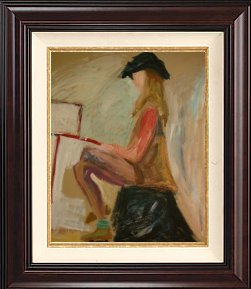|
|
|
IZA RADINSKY
ARTIST:
OIL PAINTING, ACRYLIC, WHATERCOLOUR and GRAPHIC ARTS. |

"Self-Portrait"
1972
- oil/cardboard
30.5x35.5
cm (12"x14")
------------------------------------------------------
|
|
During
the baroque and rococo periods
(17th
century and 18th century, respectively),
portraits became even more important.
During
these periods, artists increasingly studied the
facial expressions that accompanied different emotions
and they emphasized the portrayal of these human
feelings in their work. |
|

"Model
1"
1991
- acrylic/cardboard
100x70
cm (39"x29")

"All
I can remember"
2008
- acrylic/cardboard
76x76
cm (30"x30") | |
|

"Womanhood"
2006
- oil/plywood
91.5x122
cm (36"x48")
SOLD
.......................................................
|
Portraiture's
roots
are likely found in prehistoric times,
although few of these works survive
today.
These are the only paintings
of the Roman period that have survived,
aside from frescos. |

"Lyuba
the clowness"
1978
- oil/canvas
60x75
cm (24"x30")
--------------------------------------------------- |
|
In
the late 18th century
and early 19th century, neoclassical artists depicted
subjects attired in the latest fashions, which were
derived from ancient Greek and Roman clothing styles.
The artists used light that had great clarity to
define texture and the simple roundness of faces
and limbs. |
|

."Model
2"
1991
- acrylic/cardboard
100x70
cm (39"x29")
-------------------------------
|
Early
20th-century artists
expanded the repertoire of portraiture.
Fauvist
artist Henri Matisse produced powerful
portraits using nonnaturalistic, even
garish, colors for skin tones. Spanish
artist Pablo Picasso painted many portraits,
including several cubist portraits,
in which the likeness of the subject
is inferior to the stylistic appearance.
Expressionist painters provided some
of the most haunting and compelling
psychological studies ever produced. |
| |

